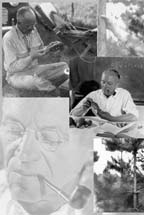We abuse land because we regard it as a commodity belonging to us. When we see land as a community to which we belong, we may begin to use it with love and respect.
Aldo Leopold
Father of Wildlife Ecology
1887-1948
 Aldo Leopold was born on January 11, 1887. He is often credited as the father of wildlife ecology. The roots of Leopold’s concept of a “land ethic” can be traced to his birthplace on the bluffs of the Mississippi River near Burlington, Iowa. As a youngster, he developed a zealous appreciation and interest in the natural world, spending countless hours on adventures in the woods, prairies, and river backwaters of a then relatively wild Iowa. This early attachment to the natural world, coupled with an uncommon skill for both observation and writing, lead him to pursue a degree at the Yale forestry school, the first graduate school of forestry in the United States.
Aldo Leopold was born on January 11, 1887. He is often credited as the father of wildlife ecology. The roots of Leopold’s concept of a “land ethic” can be traced to his birthplace on the bluffs of the Mississippi River near Burlington, Iowa. As a youngster, he developed a zealous appreciation and interest in the natural world, spending countless hours on adventures in the woods, prairies, and river backwaters of a then relatively wild Iowa. This early attachment to the natural world, coupled with an uncommon skill for both observation and writing, lead him to pursue a degree at the Yale forestry school, the first graduate school of forestry in the United States.
Graduating with a masters in 1909, he joined the U.S. Forest Service, by 1912 was supervisor of the million-acre Carson National Forest. During his tenure, he began to see the land as a living organism and developed the concept of community. In 1924 he accepted the position of Associate Director of the U.S. Forest Products Laboratory in Madison, Wisconsin, the principal research institution of the Forest Service at that time. This concept became the foundation upon which he became conservation’s most influential advocate. He began teaching at the University of Wisconsin in 1928.
Leopold was throughout his life at the forefront of the conservation movement–indeed, he is widely acknowledged as the father of wildlife conservation in America. Though perhaps best known for A Sand County Almanac, often acclaimed as the century’s literary landmark in conservation, melds exceptional poetic prose with keen observations of the natural world. The Almanac reflects an evolution of a lifetime of love, observation, and thought. It led to a philosophy that has guided many to discovering what it means to live in harmony with the land and with one another.
He was also an internationally respected scientist, authored the classic text Game Management (1933), which defined the fundamental skills and techniques for managing and restoring wildlife populations. This landmark work created a new science that intertwined forestry, agriculture, biology, zoology, ecology, education and communication. Soon after its publication, the University of Wisconsin created a new department, the Department of Game Management, and appointed Leopold as its first chair, a position he held until his death. He wrote over 350 articles, mostly on scientific and policy matters, and was an advisor on conservation to the United Nations.
Leopold’s unique gift for communicating scientific concepts was only equal to his fervor for putting theories into practice. In 1935, the Leopold family purchased a worn-out farm near Baraboo, in an area known as the sand counties. It is here Leopold put into action his beliefs that the same tools people used to disrupt the landscape could also be used to rebuild it. An old chicken coop, fondly known as the Shack, served as a haven and land laboratory for the Leopold family, friends, and graduate students. And it was here Leopold visualized many of the essays of what was to become his most influential work, A Sand County Almanac.
He died of a heart attack on April 21, 1948 while helping his neighbors fight a grass fire. He has subsequently been named to the National Wildlife Federation’s Conservation Hall of Fame, and in 1978, the John Burroughs Memorial Association awarded him the John Burroughs Medal for his lifework and, in particular, for A Sand County Almanac.
From USDA Forest Service Website
